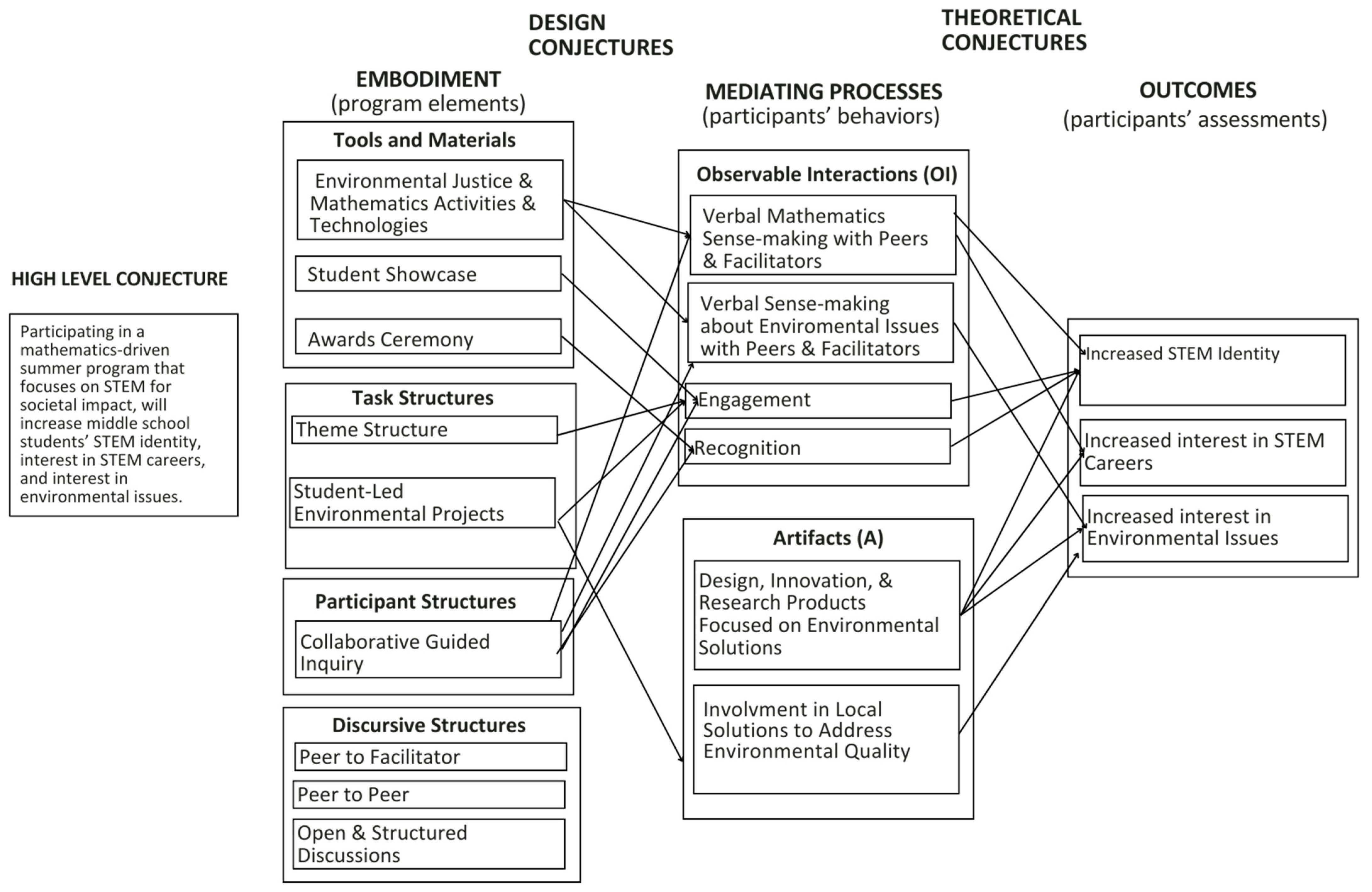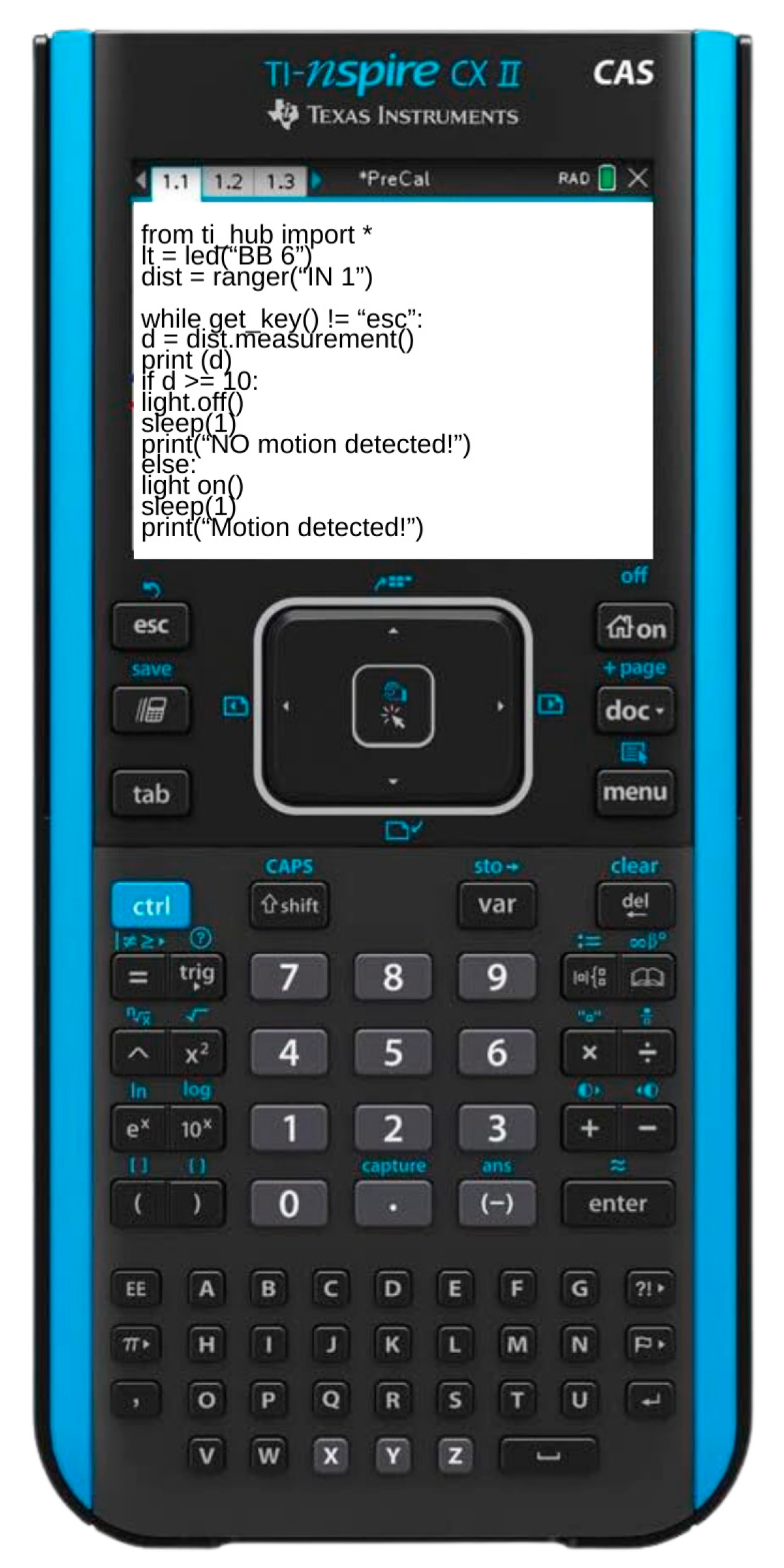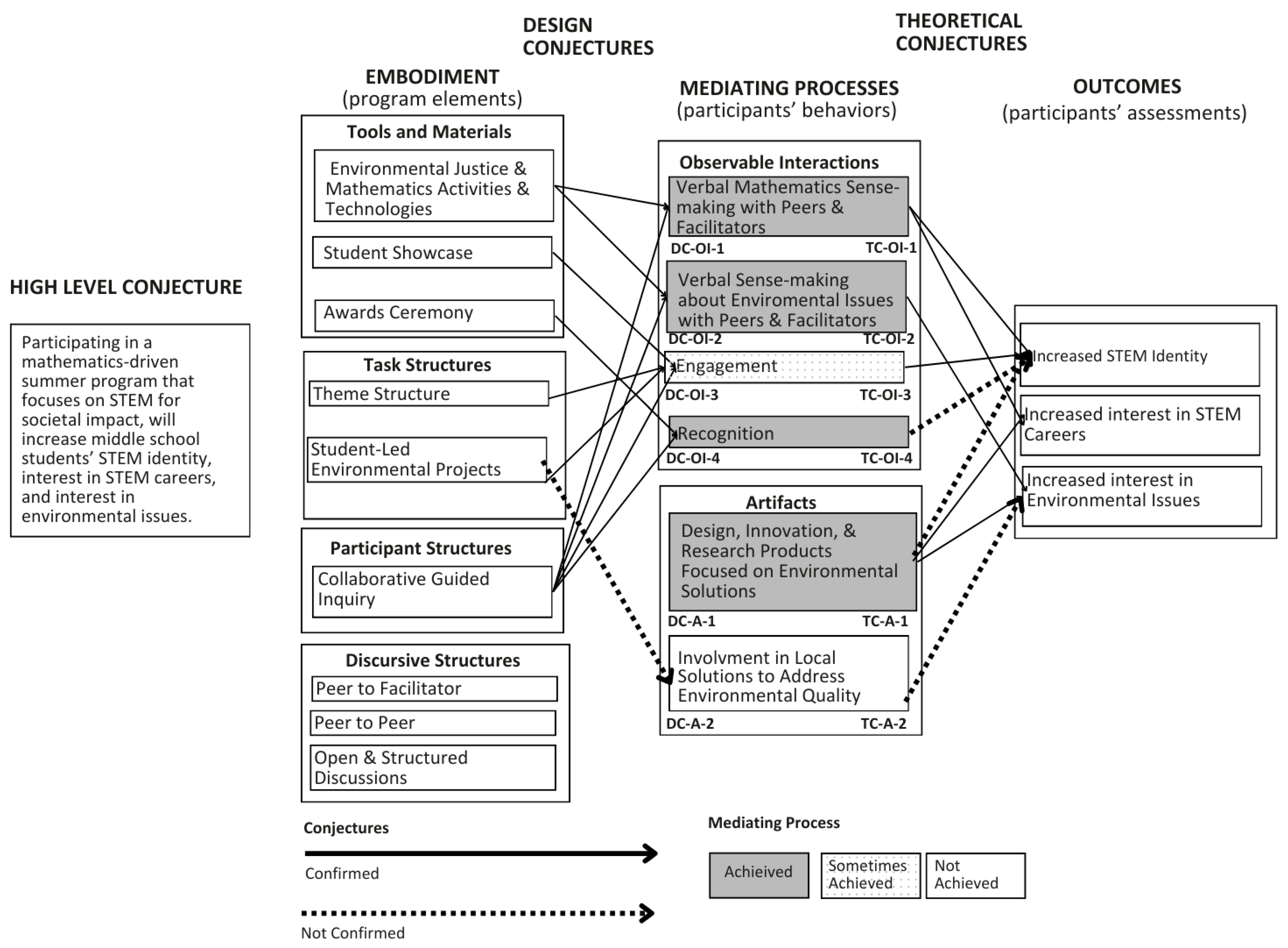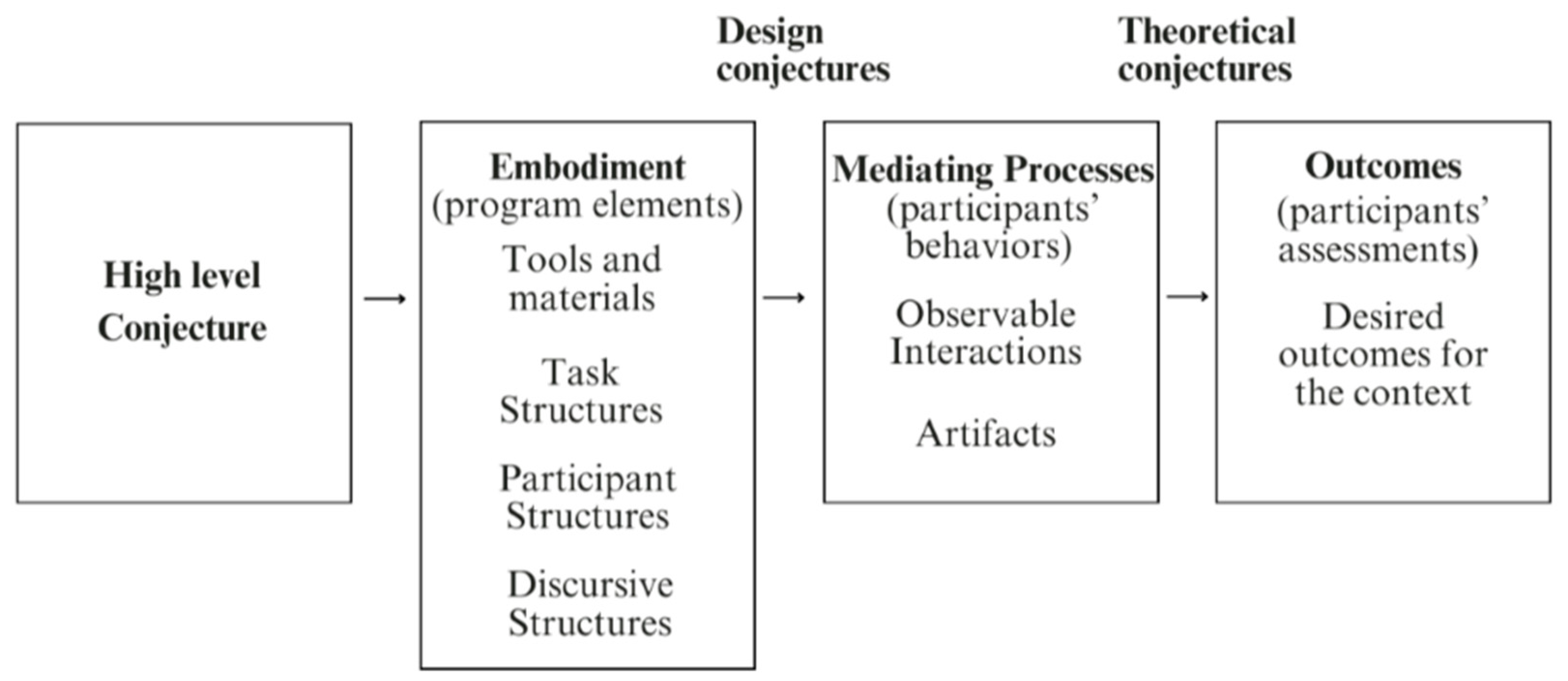Conjecture Mapping an Integrated steM Camp to Support Middle School Students’ STEM Identity and STEM Interest
Abstract
1. Introduction
1.1. Theoretical Framework: Conjecture Mapping
1.1.1. High-Level Conjecture
1.1.2. Mediating Processes: Observable Interactions
1.1.3. Mediating Processes: Artifacts
1.2. Summary
1.3. The Present Study
2. Materials and Methods
2.1. Research Design
2.2. Research Context—The Summer Camp
2.3. Participants
2.4. Ethics
2.5. Data Sources
2.6. Data Analysis
3. Results
3.1. Mediating Processes: Observable Interactions
3.1.1. Verbal Mathematics Sense-Making with Peers and Facilitators
3.1.2. Verbal Sense-Making About Environmental Issues with Peers and Facilitators
Facilitator: “Jane, what did you find?”
Jane: “Without adequate light, carbohydrates cannot be…wait. No, that’s not really it.”
Facilitator: “It’s okay if you don’t understand it.”
Jane: “Artificial light can endanger plants.”
Facilitator: “Oh! That’s a good one!”
The encouragement and assistance from the facilitators influenced the active verbal sense-making about environmental issues during the guided inquiry.Jane: “It can endanger plants and then affect animals.”
3.1.3. Engagement
3.1.4. Recognition
3.2. Mediating Processes: Artifacts
3.2.1. Design, Innovation, and Research Products Focused on Environmental Solutions
3.2.2. Involvement in Local Solutions to Address Environmental Quality
4. Discussion
4.1. Reflections on Findings
4.2. Mediating Process
4.3. Limitations
4.4. Future Research
4.5. Implications
5. Conclusions
Author Contributions
Funding
Institutional Review Board Statement
Informed Consent Statement
Data Availability Statement
Conflicts of Interest
References
- Aguirre, J., Mayfield-Ingram, K., & Martin, D. B. (2013). The impact of identity in K-8 mathematics learning and teaching: Rethinking equity-based practices. National Council of Teachers of Mathematics, Incorporated. [Google Scholar]
- Aklman, E., Barroso, L., Capraro, M. M., Creasy, T., Fleming, K., He, W., Hong, L., & Williams, A. (2019). Recycling plastics: Middle school students create solutions during a summer camp. European Journal of STEM Education, 4(1), 10. [Google Scholar]
- Allen, P. J., Chang, R., Gorrall, B. K., Waggenspack, L., Fukuda, E., Little, T. D., & Noam, G. G. (2019). From quality to outcomes: A national study of afterschool STEM programming. International Journal of STEM Education, 6, 1–21. [Google Scholar] [CrossRef]
- Amemiya, J., & Bian, L. (2024). Why are there no girls? Increasing children’s recognition of structural causes of the gender gap in STEM. Cognition, 245, 105740. [Google Scholar] [CrossRef]
- Aschbacher, P. R., Ing, M., & Tsai, S. M. (2014). Is science me? Exploring middle school students’ STE-M career aspirations. Journal of Science Education and Technology, 23, 735–743. [Google Scholar] [CrossRef]
- Barab, S. A., & Squire, K. D. (2016). Design-based research: Putting a stake in the ground. The Journal of the Learning Sciences, 13(1), 1–14. [Google Scholar] [CrossRef]
- Ben-Jacob, M. (2019). The importance of mathematics in STEM education. In EDULEARN19 proceedings (pp. 2496–2500). IATED. [Google Scholar]
- Blanchard, M., Gutierrez, K., Habig, B., Gupta, P., & Adams, J. (2020). Informal STEM program learning. In Handbook of research on STEM education (pp. 138–151). Routledge. [Google Scholar]
- Boelens, R., De Wever, B., & McKenney, S. (2020). Conjecture mapping to support vocationally educated adult learners in open-ended tasks. Journal of the Learning Sciences, 29(3), 430–470. [Google Scholar] [CrossRef]
- Broder, E. D., Fetrow, K. J., Murphy, S. M., Hoffman, J. L., & Tinghitella, R. M. (2023). STEM summer camp for girls positively affects self-efficacy. The American Biology Teacher, 85(8), 432–439. [Google Scholar] [CrossRef]
- Casey, B. (2012). Preparing for the jobs of the future. U.S. Congress Joint Economic Committee. Available online: https://www.jec.senate.gov/public/_cache/files/6aaa7e1f-9586-47be-82e7-326f47658320/stem-education---preparing-for-the-jobs-of-the-future-.pdf (accessed on 23 March 2023).
- Cen, L., Ruta, D., Powell, L., & Ng, J. (2014, December 8–10). Does gender matter for collaborative learning? 2014 IEEE International Conference on Teaching, Assessment and Learning for Engineering (TALE) (pp. 433–440), Wellington, New Zealand. [Google Scholar]
- Conway, B. M., IV, Id-Deen, L., Raygoza, M. C., Ruiz, A., Staley, J. W., & Thanheiser, E. (2022). Middle school mathematics lessons to explore, understand, and respond to social injustice. Corwin Press. [Google Scholar]
- Cribbs, J. D., Hazari, Z., Sonnert, G., & Sadler, P. M. (2015). Establishing an explanatory model for mathematics identity. Child Development, 86(4), 1048–1062. [Google Scholar] [CrossRef] [PubMed]
- Cribbs, J. D., & Utley, J. (2023). Mathematics identity instrument development for fifth through twelfth grade students. Mathematics Education Research Journal, 36, 767–789. [Google Scholar] [CrossRef]
- Cyr, E. N., Kroeper, K. M., Bergsieker, H. B., Dennehy, T. C., Logel, C., Steele, J. R., Knasel, R. A., Hartwig, W. T., Shum, P., Reeves, S. L., Dys-Steenbergen, O., Litt, A., Lok, C. B., Ballinger, T., Nam, H., Tse, C., Forest, A. L., Zanna, M., Staub-French, S., … Spencer, S. J. (2024). Girls are good at STEM: Opening minds and providing evidence reduces boys’ stereotyping of girls’ STEM ability. Child Development, 95(2), 636–647. [Google Scholar] [CrossRef]
- Dark Sky. (2024). Five principles for responsible outdoor lighting. Available online: https://darksky.org/resources/guides-and-how-tos/lighting-principles/ (accessed on 24 February 2024).
- De Lira, C., Wong, R., Oje, O., Nketah, G., Adesope, O., & Ghods, A. (2022). Summer programming camps–exploring project-based informal cs education in a rural community. International Journal of Computer Science Education in Schools, 5(4), 20–37. [Google Scholar] [CrossRef]
- Gallay, E., Flanagan, C., & Parker, B. (2021). Place-based environmental civic science: Urban students using STEM for public good. Frontiers in Education, 6, 1–10. [Google Scholar] [CrossRef]
- Geisinger, K. F. (2016). 21st century skills: What are they and how do we assess them? Applied Measurement in Education, 29(4), 245–249. [Google Scholar] [CrossRef]
- Gray, D. L., McElveen, T. L., Green, B. P., & Bryant, L. H. (2020). Engaging Black and Latinx students through communal learning opportunities: A relevance intervention for middle schoolers in STEM elective classroom. Contemporary Educational Psychology, 60, 101833. [Google Scholar] [CrossRef]
- Griffin, J., Brandt, C., Bickel, E., Schnittka, C., & Schnittka, J. (2015, March 7). Imbalance of power: A case study of a middle school mixed-gender engineering team. 2015 IEEE Integrated STEM Education Conference (pp. 64–69), Princeton, NJ, USA. [Google Scholar]
- Hirsch, L. S., Berliner-Heyman, S., & Cusack, J. L. (2017). Introducing middle school students to engineering principles and the engineering design process through an academic summer program. International Journal of Engineering Education, 33(1), 398–407. [Google Scholar]
- King, N. S., & Pringle, R. M. (2019). Black girls speak STEM: Counterstories of informal and formal learning experiences. Journal of Research in Science Teaching, 56(5), 539–569. [Google Scholar] [CrossRef]
- Kudaisi, Q. J. (2025). The Influence of Unplugged LEGO Activities on Middle Grades Students’ Computational Thinking Dispositions in a STEM Camp. Education Sciences, 15(2), 143. [Google Scholar] [CrossRef]
- Lee, V. R., Recker, M., & Phillips, A. L. (2018, June 23–27). Conjecture mapping the library: Iterative refinements toward supporting maker learning activities in small community spaces. 13th International Conference of the Learning Sciences (ICLS) 2018, London, UK. [Google Scholar]
- Leopold, H., & Smith, A. (2019). Implementing reflective group work activities in a large chemistry lab to support collaborative learning. Education Sciences, 10(1), 7. [Google Scholar] [CrossRef]
- Lindt, S., & Gupta, D. (2020). Impact of informal experiences: Changes in mathematics motivation for middle schoolers. World Journal of Education, 10(3), 88–94. [Google Scholar] [CrossRef]
- Ma, L., Luo, H., Liao, X., & Li, J. (2022). Impact of gender on STEAM education in elementary school: From individuals to group compositions. Behavioral Sciences, 12(9), 308. [Google Scholar] [CrossRef] [PubMed]
- Maltese, A. V., & Tai, R. H. (2011). Pipeline persistence: Examining the association of educational experiences with earned degrees in STEM among US students. Science education, 95(5), 877–907. [Google Scholar] [CrossRef]
- McKenney, S., & Reeves, T. C. (2019). Conducting educational design research (2nd ed.). Routledge. [Google Scholar]
- Mildenhall, P., & Cowie, B. (2021). The potential of involving communities to enhance STEM education. Teachers and Curriculum, 21(2), 9–15. [Google Scholar] [CrossRef]
- Miles, M. B., Huberman, M., & Saldana, J. (2014). Qualitative data analysis: An expanded sourcebook. Sage Publications. [Google Scholar]
- Milton, S., Sager, M. T., & Walkington, C. (2023). Understanding racially minoritized girls’ perceptions of their stem identities, abilities, and sense of belonging in a summer camp. Education Sciences, 13(12), 1183. [Google Scholar] [CrossRef]
- National Academies of Sciences, Engineering, and Medicine. (2024). Scaling and sustaining pre-k-12 stem education innovations: Systemic challenges, systemic responses. National Academies of Sciences, Engineering, and Medicine. [Google Scholar] [CrossRef]
- National Council of Teachers of Mathematics. (2014). Access and equity in mathematics education. National Council of Teachers of Mathematics. [Google Scholar]
- Noam, G. G., Allen, P. J., Sonnert, G., & Sadler, P. M. (2020). The common instrument: An assessment to measure and communicate youth science engagement in out-of-school time. International Journal of Science Education, Part B, 10(4), 295–318. [Google Scholar] [CrossRef]
- Pérez, A. (2018). A framework for computational thinking dispositions in mathematics education. Journal for Research in Mathematics Education, 49(4), 424–461. [Google Scholar] [CrossRef]
- Reid-Griffin, A. (2019). Mentoring: Helping youth make a difference in STEM. Journal of Education in Science Environment and Health, 5(1), 1–11. [Google Scholar] [CrossRef]
- Roberts, K., & Hughes, R. (2019). Girls’ stem identity growth in co-educational and single-sex stem summer camps. Journal of STEM Outreach, 2(1), n1. [Google Scholar] [CrossRef]
- Sahin, A. (2015). STEM campers on the stage (SOS): Promoting student voice and choice in STEM education through an interdisciplinary, standards-focused project based learning approach. Journal of STEM Education, 16(3). Available online: https://www.learntechlib.org/p/151970/ (accessed on 23 March 2024).
- Sandoval, W. (2014). Conjecture mapping: An approach to systematic educational design research. Journal of the Learning Sciences, 23(1), 18–36. [Google Scholar] [CrossRef]
- Schroeder, S., Stewart, B. L., & Johnson, O. (2024). Design YOU! Code camp: Lessons learned for engaging underserved youth. Journal of STEM Outreach, 7(2), n2. [Google Scholar] [CrossRef]
- Scott, E. E., Wenderoth, M. P., & Doherty, J. H. (2020). Design-based research: A methodology to extend and enrich biology education research. CBE—Life Sciences Education, 19(2), es11. [Google Scholar] [CrossRef]
- Shaughnessy, J. M. (2013). Mathematics in a STEM context. Mathematics Teaching in the Middle school, 18(6), 324. [Google Scholar]
- Stewart, C. O. (2022). STEM identities: A communication theory of identity approach. Journal of Language and Social Psychology, 41(2), 148–170. [Google Scholar] [CrossRef]
- Stewart, C. O., Campbell, J. T., Chase, T., Darbeheshti, M., Goodman, K., Hashemikamangar, S., Howland, M., Ivey, S., Russomanno, D., & Simon, G. E. (2023). Communicating identity in the Urban STEM Collaboratory: Toward a communication theory of STEM identities. International Journal of Science Education, Part B, 13(4), 345–361. [Google Scholar] [CrossRef]
- Stohlmann, M. (2018). A vision for future work to focus on the “M” in integrated STEM. School Science and Mathematics, 118(7), 310–319. [Google Scholar] [CrossRef]
- Stohlmann, M. (2019). Three modes of STEM integration for middle school mathematics teachers. School Science and Mathematics, 119(5), 287–296. [Google Scholar] [CrossRef]
- Tai, R. H., Liu, C. Q., Maltese, A. V., & Fan, X. (2006). Planning early for careers in science. Science, 312, 1143–1144. [Google Scholar] [CrossRef] [PubMed]
- Tekbiyik, A., Baran Bulut, D. E. M. E. T., & Sandalcı, Y. (2022). Effects of a summer robotics camp on students’ STEM career interest and knowledge structure. Journal of Pedagogical Research, 6(2), 91–109. [Google Scholar] [CrossRef]
- Texas Education Agency. (2012). Texas essential knowledge and skills for mathematics. Texas Education Agency. Available online: https://tea.texas.gov/sites/default/files/ch111b.pdf (accessed on 23 March 2024).
- Texas Education Agency. (2021). Chapter 112. Texas essential knowledge and skills for science subchapter b. middle school. Texas Education Agency. Available online: https://tea.texas.gov/about-tea/laws-and-rules/sboe-rules-tac/sboe-tac-currently-in-effect/ch112b.pdf (accessed on 23 March 2024).
- Tyler, K., Johnson-Glauch, N., Dean, L. M., & Krogstad, J. A. (2019, June 15–19). How outreach camps incorporate design affects female high school students’ interest in engineering and perceptions of engineering design (evaluation). ASEE Annual Conference Exposition Proceedings, Tampa, FL, USA. [Google Scholar]
- Vela, K., Caldwell, C., Capraro, R. M., & Capraro, M. M. (2019, October 16–19). The nexus of confidence and gender in an engineering project-based STEM camp. 2019 IEEE Frontiers in Education Conference (FIE) (pp. 1–7), Covington, KY, USA. [Google Scholar]
- Warshauer, H. K. (2015). Productive struggle in middle school mathematics classrooms. Journal of Mathematics Teacher Education, 18, 375–400. [Google Scholar] [CrossRef]
- Weist, L. R., & Crawford-Ferre, H. G. (2023). Middle school girls’ self-efficacy and motivation toward mathematics before and after attending an all-girls summer mathematics camp. Review of Science, Mathematics and ICT Education, 17(1), 5–22. [Google Scholar]
- Wiest, L. (2008). Conducting a mathematics camp for girls & other mathematics enthusiasts. Australian Mathematics Teacher, 64(4), 17–24. [Google Scholar]



| Week | Day | Focus of the STEM Activity |
|---|---|---|
| 1 | Tuesday | Campers used common household materials to create light. Campers use their knowledge of averages to make comparisons of light production times and duration between groups. |
| Wednesday | Campers were presented with typical and alternative histories of the innovation of electric light. Campers use their understanding of mathematics to make sense of historical documents. | |
| Thursday | Campers investigated the meaning of light pollution and its impact on plants, animals, and humans. Campers also used their understanding of mathematics to investigate the most energy-efficient lights to reduce air pollution. Campers also engaged in a mathematics warm-up where they performed calculations for percents, decimals, and fractions. | |
| Friday | Campers went on a college tour to a local university. | |
| 2 | Monday | Campers used Texas Instruments graphing calculators to use Python coding to program lights to turn off and on when someone is within a certain distance. |
| Tuesday | Campers built physical models that represented a solution to light pollution. | |
| Wednesday | In groups, campers investigated a light pollution issue that was interesting to them. Campers were encouraged to use mathematics where they felt it was relevant. | |
| Thursday | Campers practiced presenting their projects to each other. | |
| Friday | Campers presented their work to the larger community and attended a field trip to a planetarium where they learned about the sun as a source of light. |
| Scale | Definition | Format | Sample Item/Item | Scale Endpoints | # of Items |
|---|---|---|---|---|---|
| STEM Identity | Understanding of oneself as a person who can do STEM and be in STEM. | Retrospective Pre/post-test | “I think of myself as a STEM person.” | 4-point scale strongly disagree (1) to strongly agree (4) | 7 |
| Environmental Interest | Interest in environmental science. | Pre-survey/ Post-survey | “I am interested in environmental issues”. | 5-point scale strongly disagree (1) to Strongly agree (5) | 1 |
| STEM Career Interest | Interest in pursuing a STEM career. | Pre-survey/ Post-survey | “I am interested in pursuing a STEM career”. | 5-point scale strongly disagree (1) to strongly agree (5) | 1 |
| Analysis Component | Classification |
|---|---|
| Mediating Process | Achieved |
| Not Achieved | |
| Sometimes Achieved | |
| Theoretical Conjecture | Plausible |
| Not Plausible | |
| Plausible but Limited Data | |
| Insufficient Data to Comment on Plausibility | |
| Design Conjecture | Supported |
| Not Supported | |
| Supported but with Limited Data |
| Design Conjecture Supported, Not Supported, Supported with Limited Data | Theoretical Conjecture Plausible, Not Plausible, Plausible but Limited Data, or Insufficient Data to Comment on Plausibility | |
|---|---|---|
| 1 | The use of environmental justice and mathematics activities and technologies, standards aligned, and collaborative guided inquiry will solicit students’ verbal mathematics sense-making with peers and facilitators. Outcome: Supported | If students participate in verbal mathematics sense-making with peers and facilitators, then there will be an increase in STEM identity and an increased interest in STEM careers. Outcome: Plausible |
| 2 | The use of environmental justice and mathematics activities and technologies, standards aligned, and collaborative guided inquiry will aid students in creating verbal mathematics sense-making with peers and facilitators regarding environmental issues. Outcome: Supported | If students participate in verbal sense-making with peers and facilitators regarding environmental issues, then there will be an increased interest in environmental issues. Outcome: Plausible |
| 3 | The use of collaborative guided inquiry, student-led environmental projects, theme structure, and an awards ceremony will engage students. Outcome: Supported | If students are engaged, then there will be an increase in STEM identity and an increase in interest in STEM careers. Outcome: Plausible |
| 4 | An award ceremony will provide recognition to student participants. Outcome: Supported | If students are recognized, then there will be an increase in STEM identity and an increase in the interest in STEM careers. Outcome: Insufficient Data to Comment on Plausibility |
| 5 | When student-led environmental projects are presented in the program, design, innovation, and research products are created. Outcome: Supported | If students engage with the design, innovation, and research products focused on environmental solutions, then there will be an increase in STEM identity, increased interest in STEM careers, and increased interest in environmental issues. Outcome: Insufficient Data to Comment on Plausibility |
| 6 | The sixth and final program element conjecture is that when student-led environmental projects are presented, there is involvement in local solutions to address environmental quality. Outcome: Not Supported | If students engage with the involvement in local solutions to address environmental quality, then there is increased interest in environmental issues. Outcome: Insufficient Data to Comment on Plausibility |
| N | Pre-Survey | Post-Survey | Mean Change | Significance Test | ||
|---|---|---|---|---|---|---|
| Outcomes | Mean (SD) | Mean (SD) | +/− | z | p | |
| STEM Identity | 12 | 2.58 (0.73) | 3.04 (0.67) | +0.46 | 2.48 | 0.04 * |
| Interest in Environmental Issues | 13 | 3.25 (1.36) | 3.67 (0.98) | +0.42 | 0.50 | 0.31 |
| Interest in STEM Careers | 13 | 2.75 (1.22) | 3.58 (1.16) | +0.83 | 1.51 | 0.06 |
Disclaimer/Publisher’s Note: The statements, opinions and data contained in all publications are solely those of the individual author(s) and contributor(s) and not of MDPI and/or the editor(s). MDPI and/or the editor(s) disclaim responsibility for any injury to people or property resulting from any ideas, methods, instructions or products referred to in the content. |
© 2025 by the authors. Licensee MDPI, Basel, Switzerland. This article is an open access article distributed under the terms and conditions of the Creative Commons Attribution (CC BY) license (https://creativecommons.org/licenses/by/4.0/).
Share and Cite
Kudaisi, Q.J.; Leonas-Cabrera, M.J. Conjecture Mapping an Integrated steM Camp to Support Middle School Students’ STEM Identity and STEM Interest. Educ. Sci. 2025, 15, 159. https://doi.org/10.3390/educsci15020159
Kudaisi QJ, Leonas-Cabrera MJ. Conjecture Mapping an Integrated steM Camp to Support Middle School Students’ STEM Identity and STEM Interest. Education Sciences. 2025; 15(2):159. https://doi.org/10.3390/educsci15020159
Chicago/Turabian StyleKudaisi, Queshonda J., and Michael J. Leonas-Cabrera. 2025. "Conjecture Mapping an Integrated steM Camp to Support Middle School Students’ STEM Identity and STEM Interest" Education Sciences 15, no. 2: 159. https://doi.org/10.3390/educsci15020159
APA StyleKudaisi, Q. J., & Leonas-Cabrera, M. J. (2025). Conjecture Mapping an Integrated steM Camp to Support Middle School Students’ STEM Identity and STEM Interest. Education Sciences, 15(2), 159. https://doi.org/10.3390/educsci15020159








